The Olive Harvest Lunch
by mimithorisson
The man who liked olive trees
Several years ago I interviewed a Swedish chef in Paris. A young man with good looks and pretty dreams. He told me that one day he’d like to live in the countryside, grow his own vegetables, have dogs. I asked him if he wanted to realize these dreams back home in Sweden. He thought about it for a few seconds and said “No, not that I don’t like Sweden but my farm must have olive trees so I need to be somewhere south. Probably Italy or southern France.” I never saw him again and frankly I had all but forgotten about him until last year when we were planning to move into our new house and needed to tidy up the garden. When 1 rue de Loudenne was known as “Hotel de France” they had big trees in the courtyard in front of the house and even some, rather out of place, palm trees, probably to add an exotic touch. But when we came into the story there was nothing left but weeds, a few out of shape bushes and a handful of roses that were surviving against the odds. We always knew that we’d want to a Magnolia tree so that went in first but what else should we plant?
Oddur and I love olives and olive trees but somehow Médoc had never felt like that kind of place. You can see a few olive trees here and there but this is hardly olive country. We consulted our gardener, Nicolas, about the wisdom of investing in several olive trees and got the typical “French” answer. Normalement it would be fine … unless it wouldn’t be fine. When pressed he was ready to go further and say that the chances of the trees being fine were greater than of them not being fine. Oddur (who thinks a 20% chance of something happening is pretty good) took that as an absolute green light and since I’m not without a sense of risk taking myself I jumped on board.
So now we have a little or rather a tiny olive grove in front of our house, we have many dogs, we grow our own vegetables and we live in the south of France.
Next time someone tells you their dreams you should listen carefully, they might in fact be disclosing your own.
The olives that vanished
In November last year, a few weeks before we finally moved in, we planted one 70 year old, big olive tree and a few smaller ones in the courtyard in front of 1 rue de Loudenne. It felt a bit like cheating but the big ones had tons of olives on it already when we got it. And when I say tons I mean something like 15 – 20 kilos, which in new olive farmer language translates as tons. Nicolas, the gardener, and his wife were helping us out with painting the rooms and every day we’d take a look at the olives and debate if they were ready. Oddur was impatient, so was I but Nicolas insisted we wait a little, they “need a few more days” he always said. Then one evening at dusk, during our daily olive talk and deliberations about the best way to handle them once picked (plain water or salted and then after which herbs and oils to use) Nicolas lost his patience and said “let’s just pick them now”. So out we went, buckets in hand to finally get our hands on those purple black, glistening olives. But they were gone, every single one. They had been there yesterday, but it seemed as if they had evaporated before our eyes during the night or even during the day as we were painting. We searched the ground for clues and found, where there should have been at least some evidence, not a single olive, not a broken branch. Nothing at all.
The garden was left unguarded during the nights as we hadn’t moved in yet but who would steal olives in the night, with such precision and neatness. Surely the most meticulous thief would drop some olives in the dark, or at least one. So we turned our attention to birds. Do they like olives? We thought not. We knew they liked cherries but those are sweet. Olives, freshyly picked let’s face it, taste terrible. So we just scratched our heads, finished the painting and were left to wonder what had happened. The mystery of the evaporated olives remained just that. Not of the sort maybe to bring Sherlock Holmes or Hercule Poirot out of retirement but big enough to get a little village quitely talking.
Oddur and I discussed how this was the perfect material for a short story. The disappearing olives in the quiet village. Of course we have different litterary takes on it. My husband likes realism, he likes Chekhov and Lucien Freud. I like South American litterature and Gustav Klimt. His fictional version of events goes like this (of course the dogs are the heroes in his story): One day when we’re walking the dogs in the village they pick up a familiar scent, something they recognize from our garden, and lead us to a beat up but beautifull house just outside St Yzans. It’s walls are terracotta pink and there is a single, beautiful olive tree just in front of the house. We politely knock on the door and the man who greets us, olive-skinned and big nosed, hesitantly invites us into his humble dining room. It’s sparsely decorated but the outstanding piece is a crystal bowl filled with the most luscious olives. The man knows that the game is up and graciously invites us to his cellar where there are hundreds of jars of cured olives lining the humid walls. Every one is meticulously numbered and signed. The man readily admits his crime but instead of showing any sign of remorse he offers, as penance, to cook us a meal, starred with olives. He takes out the finest cuts of ham, the best wines and together we cook an olive-macerated feast that carries on into the night. Then we leave, happy. My (more accurate version – for this is what really happened) is like this: One night I wake up and something calls me to my bedroom window towering over the garden and all the olive trees. The dogs are sleeping and don’t notice anything but what at first seems like bird or bats swirling around the trees are in fact legions of women in black dresses floating in the air, picking olives and placing them carefully in baskets lined with the finest silks and chiffons. Having no fear of them I grab a dress of my chair, that happens to be black also, and glide down the stairs to join them. They lead me into my kithcen, which is now their kitchen and together we wash the olives, cure them in saltwater and lay them in carefully crafted crystal jars with silver lids. The floors are covered in olive branches and leaves and though we are barefoot, walking on them feels like walking on the finest velvet carpet. We make a simple soup together, not with olives but with herbs and vegetables and have it with the most delicious wine I have ever tasted. Then each of the women takes a jar, clutches it to her chest and glides into the darkness outside. The last one, Plantia, takes the last jar and places it in my hand, then floats into the night. The next morning I wake up happy and run down the stairs to find my olives. They are gone but a few months later, in the cellar under our house, when the olives are ready, I find the jar again. I use them to cook a meal for my family. The best meal we’ve ever had.
My fantastcial story makes much more sense than my husband’s because, if you think about it, an army of flying women is much more likely to gently pick the olives without a trace than one old man. But to each his own!
The wet lunch
This year we were determined not to lose our olives at any cost and decided to harvest before December. But it had to be special. The harvest this year, despite us planting even more trees, is smaller than last year – the trees need time to adjust. We decided to do it on a Wednesday, when kids don’t have school and we thought it was a good idea to invite our dear friends Fabien and Florence who have a winemaking Château and have invited us to so many harvest lunches (where there’s actually a real harvest). The Wednesday in question arrived and though it was pouring with rain Oddur was upbeat. “It’s even better” he said – “who wants to pick olives in the sun”. I wasn’t really convinced “hum, probably everyone” was my answer. But we went ahead and though it was wet it was wonderful. Fabien, as always, brought a case of his wine, Château Tour Haut-Caussan, this time the 2012 which we hadn’t tasted before. It’s young, but I liked it, already round and lovely … as wine experts would say. Mathis (Fab and Flo’s son) charmed the girls, who won’t admit it but they all want to marry him, except maybe Mia who’s in his class. Allegra and I prepared the apples, cooked the pork, baked the madeleines. Gaïa and Louise pouted and shouted a lot. There were two colors of Champagne, courtesy of a very lovely guy called Nicolas who is the brand manager at Ruinart. He’s French, lives in NY but was back home on some family business. When a mutual friend (Mr W. M. Brown) told Nicolas that Ruinart Rosé was my favorite Champagne he decided to stop by a workshop and treated everybody to loads of Champagne. And luckily he left us a few more bottles. He also told us some good champagne stories. Nicolas told us that the first customers of Champagne were the king at Versailles and his court. They liked the bubbly feeling and wanted more. One of the king’s advisers, a monk, and Mr. Ruinart’s cousin, noticed the trend and told his cousin to use the family lands to make this new, refreshing drink. The rest is history – à votre santé!
Our crop in tons or kilos is a bowl. A big one that’s now filled with water that my husband changes religiously every day. As I am writing this the olives are still terribly bitter but beautiful to look at. They live in the “boucherie” (my other kitchen) far from the grasps of old men and flying ladies in black.
We will enjoy having them in the spring, but first Christmas!
p.s.
Talking of Christmas and the presents that go with it I wanted to give you all an update of the workshops and their availability. We’ve had such incredible response to the announcement of the 2016 workshops that by now most of them are full. But, perhaps luckily for some of you, not all. There are still some spaces left in the March and April ones. May through September is completely full to say the least. October is getting there but November and December still have a few spaces left. So if any of you are interested please send a mail to mangerworkshop@gmail.com Here’s a link to the post explaining the workshops.
Baked apples with goat’s cheese, lardons & walnuts
8 medium-sized apples
230 g/8 ounces goat’s cheese
230 g/8 ounces lardons
A handful of walnuts
2 tablespoons honey
Salt & pepper
Preheat the oven to 350°F/180°C
In a sauté pan, cook the lardons on a medium heat and cook until golden.
Slice the top of the apple and set aside. Core and slightly hollow out the apples with a spoon, leaving the bottom of the apples intact to create a well for the filling. Stuff about a tablespoon of goat’s cheese, a few crumble walnuts and the lardons. Place in a baking dish, drizzle with honey. Transfer baking dish in the preheated oven for 15 minutes, or until apples are golden.
Serve with a mâche salad.
Pommes farçies au fromage de chèvre, lardons et noix
8 pommes de taille moyenne
230 g/ 8 ounces fromage de chèvre
230 g/ 8 ounces lardons
Une poignée de noix, légèrement hachées
2 cuillères à soupe de miel
Sel et poivre
Préchauffer le four à 350 °F/ 180 °C
Faites dorer les lardons dans une poêle. Réserver.
Laver les pommes et couper le haut (pour obtenir un petit chapeau). Mettez de côté.
Creuser la pomme légèrement avec une petite cuillère afin d’avoir assez de place pour le fromage, les noix et les lardons – faites attention de ne pas percer le fond.
Mettre environ une cuillère à soupe de fromage, puis quelques lardons et noix. Ajouter un filet de miel et quelques tours de poivre du moulin. Remettre les petits chapeaux, arroser encore de miel et enfourner pour environ 15 minutes. Servir chaud avec une petite salade de mâche.
Roast Pork loin with Balsamic vinegar and red wine
2 kg/4.2 pounds approx boneless pork loin
A few sprigs of fresh thyme
1 tablespoon fennel seeds
Olive oil
240 ml/ 1 cup balsamic vinegar
15 cloves of garlic, unpeeled
2 bay leaves
120 ml /½ cup red wine
Coarse sea-salt and freshly ground black pepper
Preheat the oven to 350°F/ 180°C.
Score the pork loin skin side and season with salt and pepper. Crush the fennel seeds with a mortar and pestle. Sprinkle the thyme and fennel seeds on both sides.
In a large frying pan, (or stove-proof/oven-proof roasting pan), heat olive oil on a high heat. Brown the pork loin skin side first, until the skin is golden. Turn on the other side and cook for a couple of minutes. Pour the balsamic vinegar and turn the pork loin on both sides. Leave to bubble and reduce for 2 minutes and transfer to the roasting pan along with all the juices.
Place 15 unpeeled slightly crushed garlic cloves around the meat. Check the oven regularly and add a bit of water if needed. Place in the preheated oven for 1 hour and 10 minutes, or until the meat is cooked through. Halfway though, pour the red wine.
Leave the meat to rest for 10 good minutes before carving. Serve with mashed potatoes.
Rôti de porc au vinaigre balsamique
2 kg rôti de porc (échine ou filet), désossée
Quelques brins de thym frais
1 cuillère à soupe de graines de fenouil
Huile d’olive
240 ml vinaigre balsamique
15 gousses d’ail en chemise
2 feuilles de laurier
120 ml vin rouge
Gros sel de mer et poivre noir fraîchement moulu
Préchauffer le four à 350 °F/ 180°C.
Faites un quadrillage sur le côté peau du porc et assaisonner avec le sel et poivre. Ecrasez les graines de fenouil avec un mortier et pilon. Saupoudrer le thym ainsi que les grains de fenouil sur les deux côtés.
Faire chauffer l’huile à feu vif dans une grande cocotte pouvant aller au four et faire revenir le porc des deux côtés pendant quelques minutes. Le côté peau doit être doré.
Déglacer avec le vinaigre balsamique. Retirer du feu, ajouter les gousses d’ail, les feuilles de laurier.
Surveiller la cuisson pour ne pas laisser la sauce brûler. Ajouter un peu d’eau si necessaire. À mi-cuisson, verser le vin rouge. Enfourner pour 1 heure et 10 minutes, environ.
Laisser la viande reposer pendant 10 minutes avant de server. Servir avec une purée de pommes de terre.
Vanilla chestnut cream madeleines
For about 20 madeleines
200 g/ 7 ounces chestnut cream
100 g/ ½ cup sugar
2 eggs
100 g/ ¾ cup + 2 tablespoons flour
90 g/ 6 tablespoons butter, melted
2 tablespoons rum
1 teaspoon baking powder
1 teaspoon vanilla extract
In a bowl, mix the eggs and sugar.
Then stir in the flour and baking powder. In another bowl, combine the butter, rum, vanilla
and chestnut purée.
Mix both mixtures with a wooden spoon.
Butter a madeleine pan, bake at 200°C/ 400°F for 5 min, then 180°C/ 350°F another 8 min or until golden brown. Unmold immediately and leave to cool on a pastry rack.
Madeleines à la crème de marrons
200 g crème de marrons
100 g sucre en poudre
2 oeufs
100 g farine tamisée
90 g beurre doux, fondu
2 cuillères à soupe de rhum
1 cuillère à café d’extrait de vanille
1 cuillère à café de levure chimique
Dans une grand bol, mélangez les oeufs et le sucre.
Ajouter la farine tamisée et la levure. Dans un autre bol, mélanger la crème de marron, le beurre ramolli, le rhum et la vanille. Incorporer au mélange oeufs/farine.
Beurrer un moule à madeleines, verser la pâte dans à trois quart de hauteur. Enfourner à 200°C pendant 5 minutes, puis baisser la temperature à 180°C et continuer la cuisson pendant 8 minutes. Sorter les madeleines du four, démouler-les immédiatement sur une grille pour laissez refroidir.

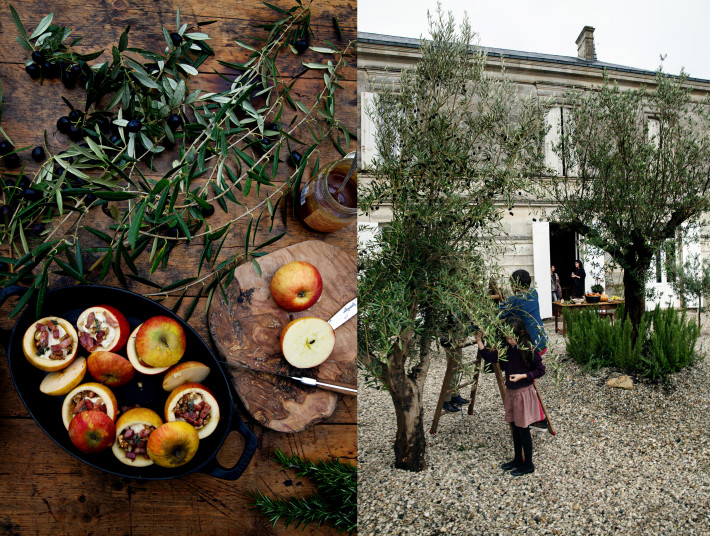
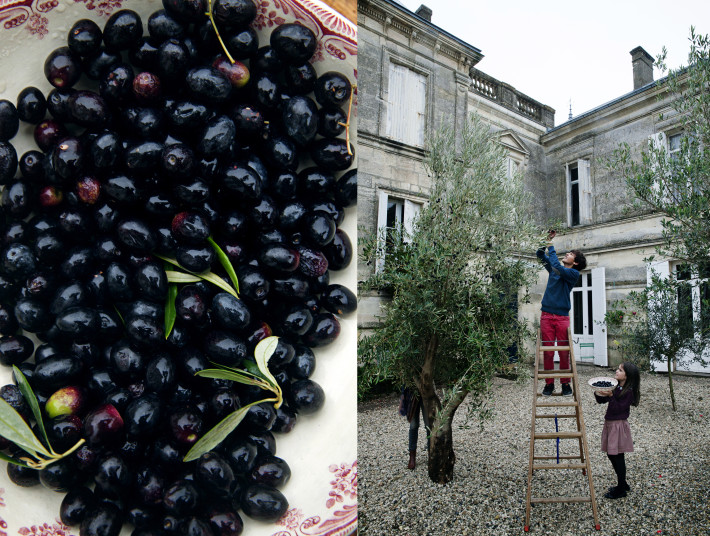
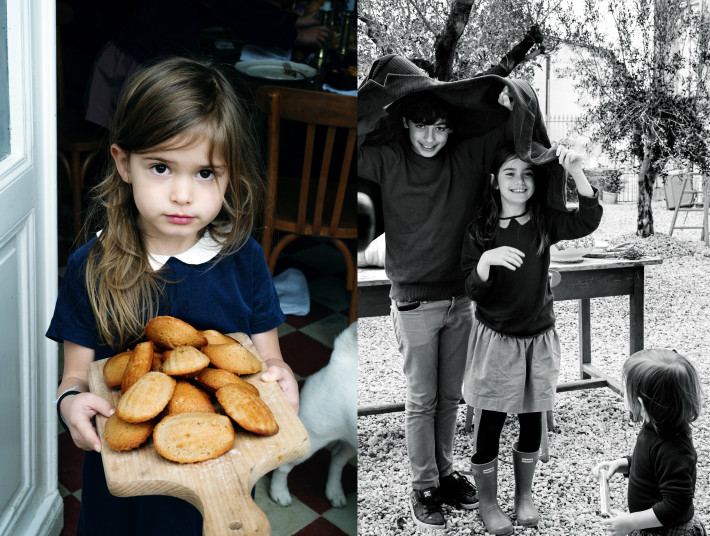
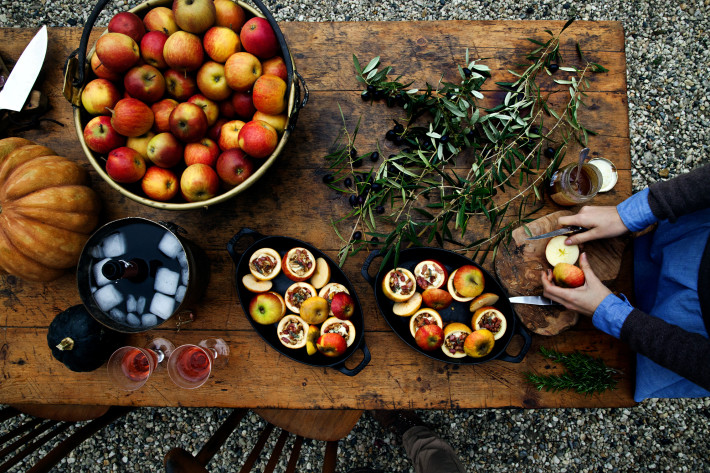
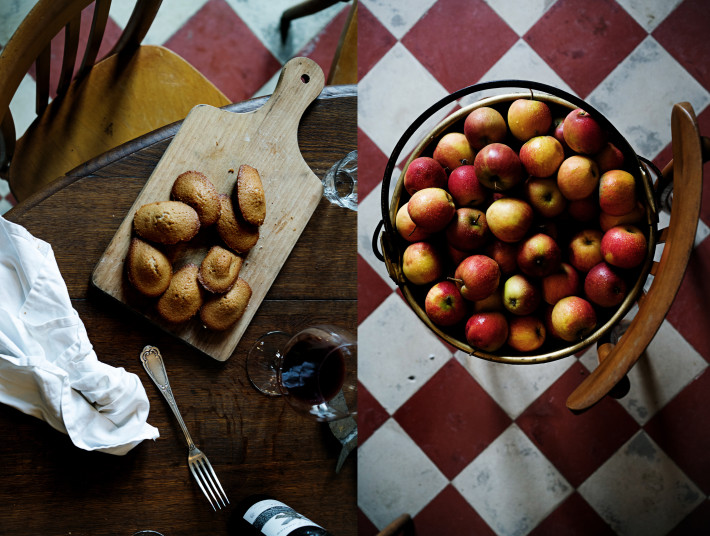
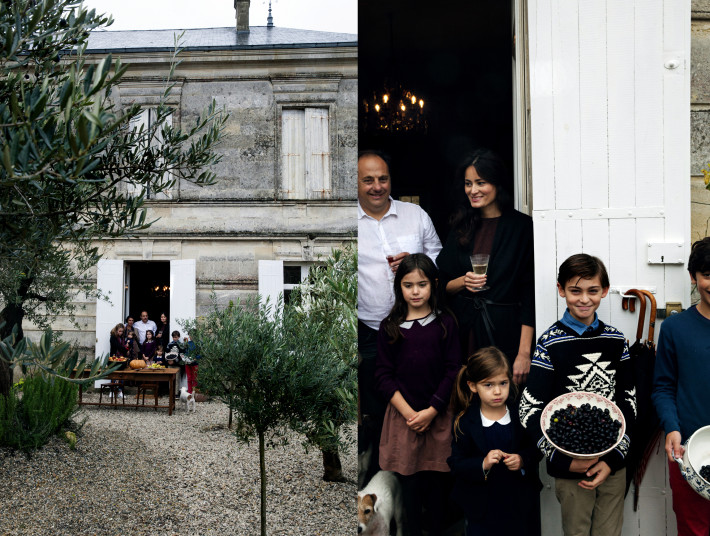
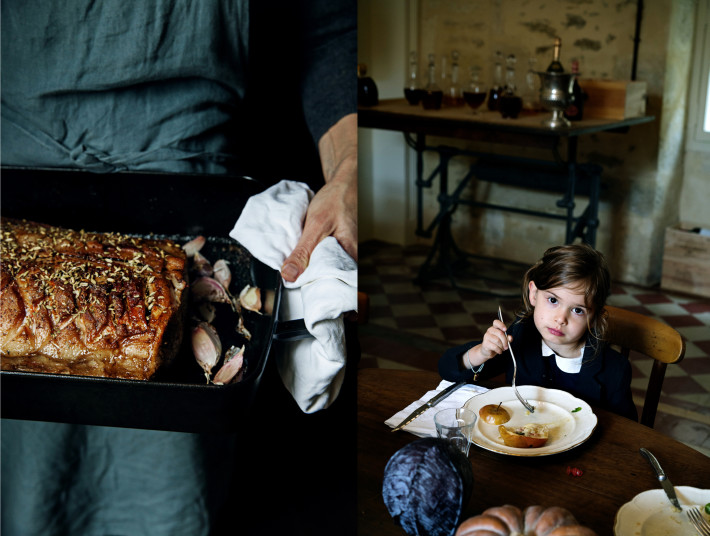
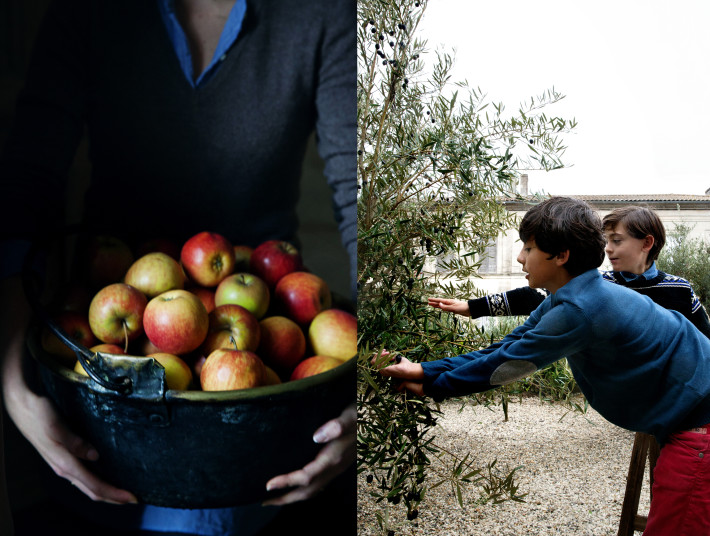
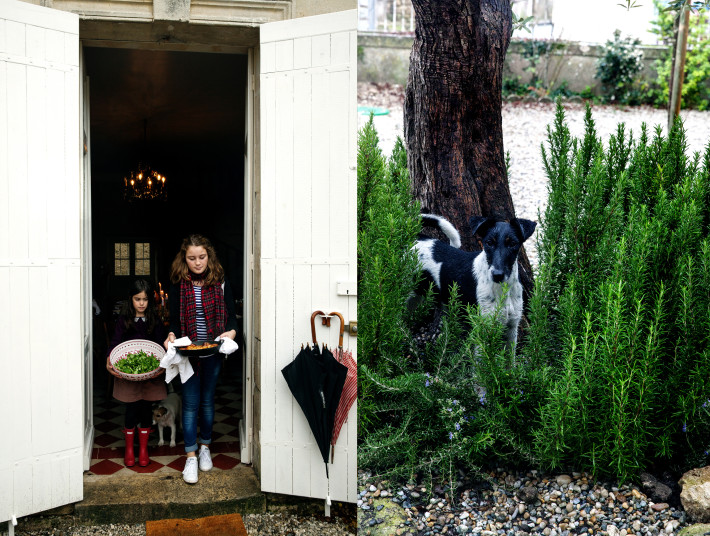
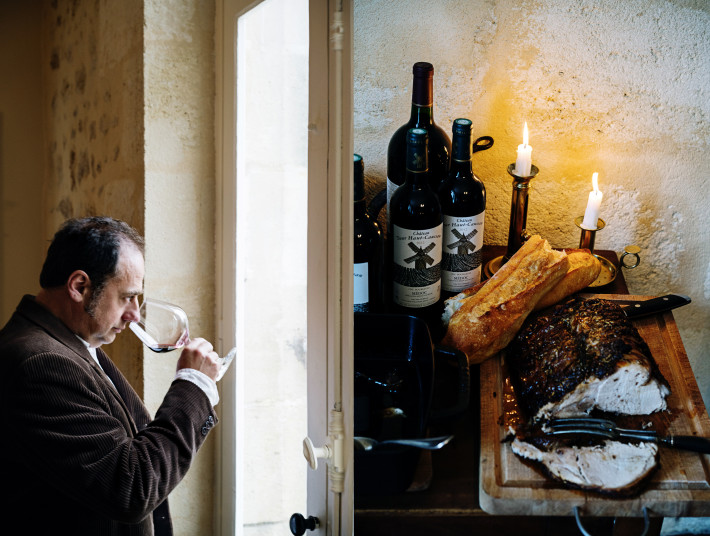
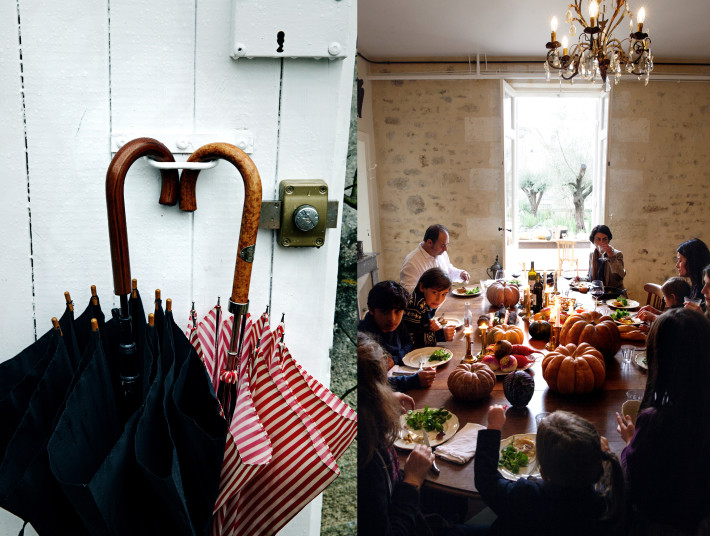
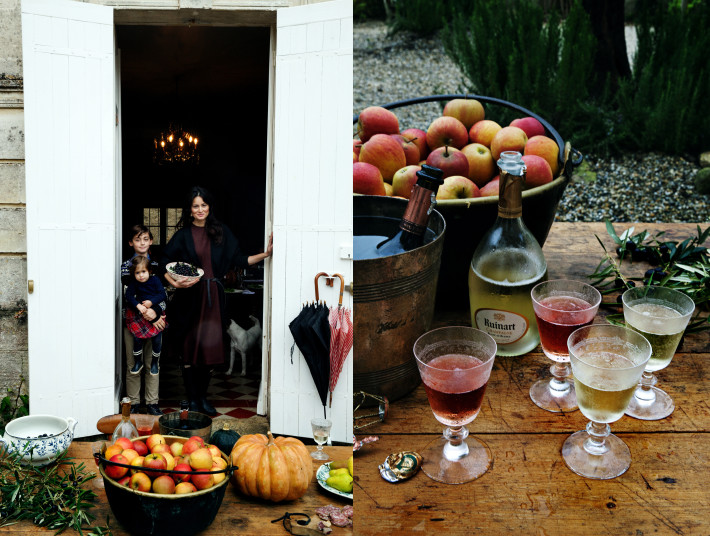
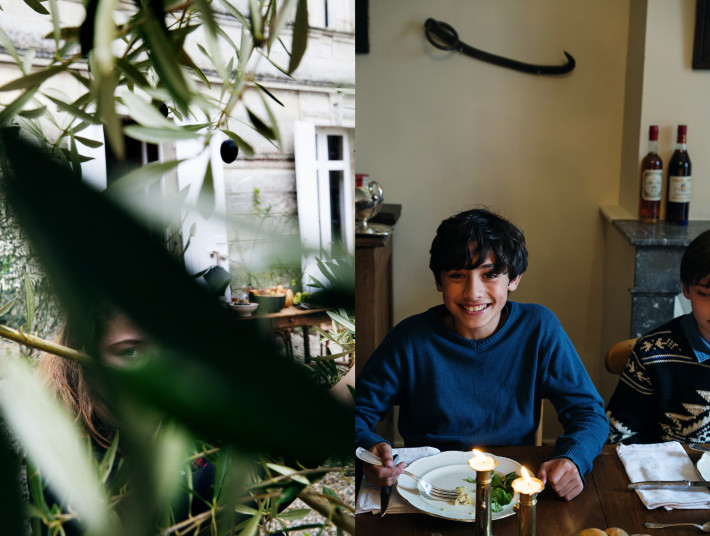
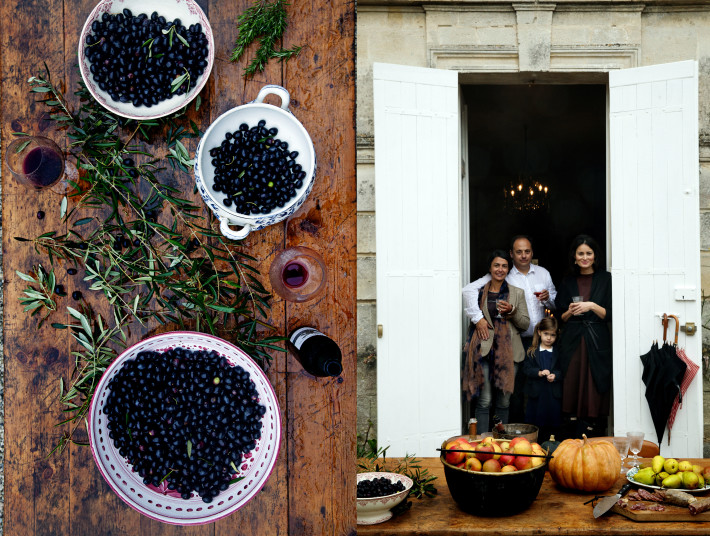

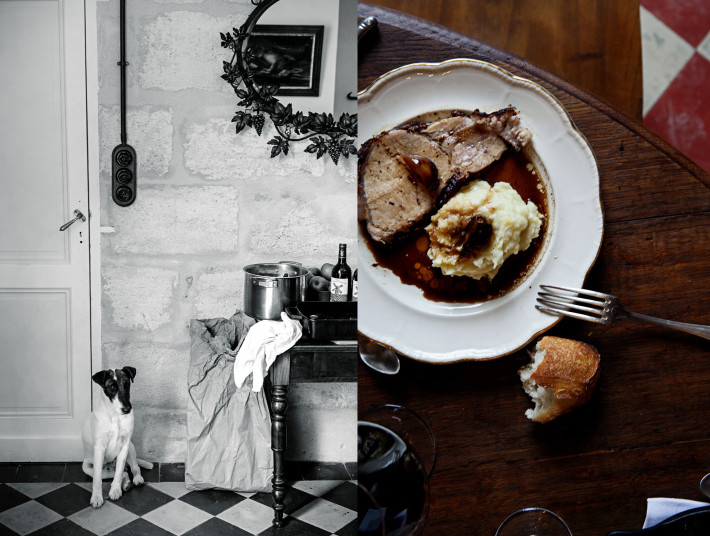
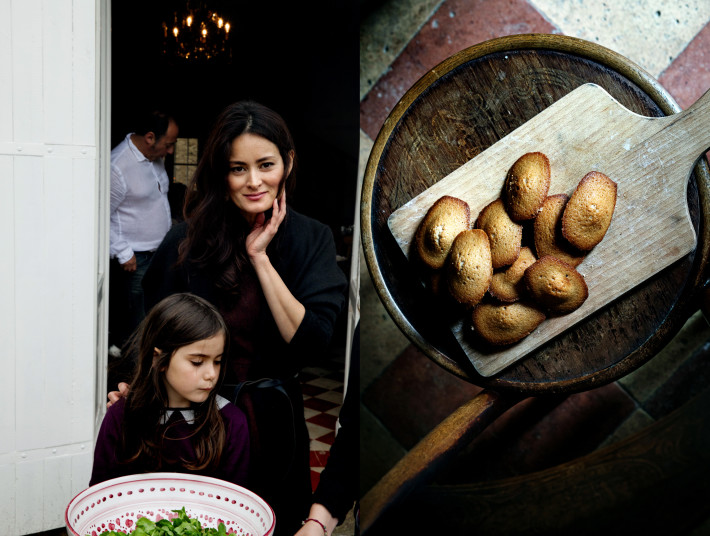
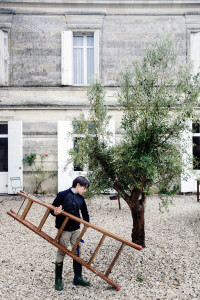
You always adorable your family and our lifestyle <3
🙂 Merci! xx
Oh, so wonderful to read. It’s a rainy week here in Canada and I’m glad to hear Oddur call it something to be enjoyed 🙂 As usual, love to see your family working and eating together!
Thank you Josephine! Always happy to share our latest post, recipes and a fun story to go with it! Enjoy the recipes, Mimix
Hi Mimi! Glad to see you back! Your madeleine recipe sounds beautiful (and if I may admit, easier than most haha)! I will try it soon and let you know how it goes! 🙂
Thank you & have a beautiful Christmas season x bisous
Ps. I just received the My Little Box and what a lovely surprise to see you inside 😀
Pps. Ruinart Rosé is also my favorite – the bottle, the color!
Bonjour Jasmine! Glad to hear you liked My Little Paris box, it’s very cute and the team were so sweet. I am using the tins for my vanilla sugar and chocolate bars. Enjoy the madeleines, I like them fresh from the oven! Mimix
Lovely story! I look at my olive trees and wonder when we will have fruit!
Thank you Beverly! Patience, patience, the fruit will come soon! x
My favorite champagne is Ruinart Rose, used to be Billecart Salmon, but fell in love with Ruinart!
Have a wonderful holiday season Mimi.
xo
They ar eboth great champagnes, but Ruinart is the one, right? The bottle is like a perfume. 🙂 Enjoy this festive month! Mimi x
Wow! Those olive trees are stunning. How does one acquire a 70-year-old olive tree that can survive transplanting! Fascinating.
They are, right? We’ve been lucky, and treating them with much love. 🙂 Happy December! Mimix
May the season of reflection and joy be blessed with Love , Joy , and Wisdom.
Thank you for your posts, they help keep me hopeful and sane.
Blessed Be to all your loved ones
Thank you for such kind words Wes! Happy festive month! Mimi x
The recipes look delicious, I can’t wait to try! And I greatly enjoyed both versions of what happened to the olives. I could certainly see the influence of South American writers in your story, but Oddur’s version read less like Chekhov and more like one of your blog posts. 🙂 Thanks for sharing.
Bonjour Kathleen,
When I was 16, I fell in love with South American and Spanish literature. I had a wonderful teacher, she made us feel the magic lingering between the lines. It has inspired me ever since those days… it’s all about the magic in our lives! Happy festive month! Mimi x
Your stories are always beautiful and magical. You mentioned South American literature and I wanted to ask you for recommendations. I’m from South America myself, Ecuador to be more specific. However I grew up in the US and learned more about America writers than South American (sad I know). I know the classic writers like Gabriel Garcia Marquez, Isabele Allende but if you could introduce me to other writers I would be delighted. Gracias.
So happy to see another beautiful post, Mimi !! I had just come in from running errands in the rainy, cold weather, and decided to sit down to a big, warm latte and muffin, while checking emails on my cellphone. The neighbors must have heard me gasp when I saw a post from Manger had arrived. “It’s HER, oh goody, she wrote again !” Even in teeny-weeny cellphone format Oddur’s photos are stunning, enchanting, they pull me into your world. Your olive stories are hilarious – I like the way Plantia made it into yours – but I was hoping the olive thief would have come clean in the end, in reality. Christmas is just around the corner – thanks for giving me new and exciting ideas for festive dinners. Your Cooking Workshop has stayed with me all through this year, ever since May – it’s just an experience that lasts, that you take with you. Now I have to go find Ruinart Rose champagne – thanks for the tip! 💖Linny
Magic storyline set with stunning photos Mimi and Oddur. May your festive season be exactly that. I laughed when I remembered the post regarding Oddur’s determination to celebrate Christmas at 1 Rue de Lourdonne. This year you will enjoy the real fruits of your labours! May peace and goodwill prevail (along with much Champagne and your stunning cooking). Hot, hot here in Australia already – at least we live 200 metres from the beach. This year I suspect cold dinner will be the order of the day…
Thank you Jude! Happy festive month – wishing you all the best, Mimi x
Bonjour dearest Linny! Can you believe we are already approaching Christmas? We’re getting our tree on Friday, it’ll get all festive here in 1 Rue de Loudenne! So happy to hear you enjoyed the post, now you can enjoy the recipes! Wishing you a happy cheerful month! Big hugs, Mimi x
Wonderful family Mimi!
Shruthi
http://nyambura.co
Merci! x
Oh my goodness, this was enchanting. (Those disappearing olives!) Thank you so much for sharing such vivid, beautifully engaging stories, and for such vibrant photos and recipes to go along with them. And especially for this line: “Next time someone tells you their dreams you should listen carefully, they might in fact be disclosing your own.”
Thank you Cynthia! 2 years before we left for the Médoc, Oddur and I were working on a food/restaurant guide on Paris. Our daily activities were unforgettable, eating at all our favorite restaurants, meeting all those great chefs! One thing led to another, each encounter brought me golden wise words that inspired me all the way to the Médoc. I truly believe in signs, don’t you? 🙂 Happy holidays (soon!). Mimi x
I wonder what happened to that Swedish chef? Lovely post as usual Mimi!
Good question! He was a chef at the restaurant ‘la Gazzeta’ in Paris… I’ll follow-up! 🙂
What a lovely story and beautiful images!!! I love that you all have this blog as your family memoir! 🙂
I will be sure to listen to anyone speaking about dreams! 🙂 My favorite book is The Alchemist…a beautiful, simple book about dreams. I will also have to make the madeleines! YUMMY!!! xo, Dana
Bonjour Dana! Dreams are always inspiring! Happy holidays! Mimi x
Oh, Mimi. I think I will read this post over several times. I am homesick for 1 rue de Loudenne! There are so many details you convey that touch my heart – especially the 20% chance of something happening… ha ha! I remember the stories you and Oddur told of the first olive harvest and felt such sadness of the loss!! I am so very happy to hear the details of the first TON harvest and cannot wait to hear of the feast you will have with them! There is so much more to say, but I shall save it for a letter. The stories and pictures of this post are elegant and mesmerizing! Thank you for sharing the goodness and beauty with us.
Thank you my dear! Big hugs to you and Meghan!
J’ai adoré lire cette histoire, les oliviers me rappellent tellement le sud de l’Espagne! La recette des pommes me plaît beaucoup, je crois que vais l’essayer et aussi le rôti ! Pour les madeleines, j’en fait à la crème de marrons il n’y a pas longtemps. On a beaucoup aimé! Très beau post Mimi, c’est toujours un plaisir te lire et contempler les photos sublimes! Joyeux mois de décembre! x
Merci Eva! C’est un plaisir d’être entourée d’oliviers dans notre petit jardin! Je vous souhaite un beau mois de Décembre! Mimix
Hello Mimi,
Your post always arrives just at the point when I am beginning to feel like a tired pilgrim who seeks refuge…I have eaten a warm and delightful meal, I have rested. Thank you once agian!!
I don’t know, I would like to see good ol’ Monsieur Poirot come out of retirement, just for this last one.
As I too, favor the flavor of Latin America Lit., I would like to add that it was the lost strange pilgrims seeking…well, that’s for one’s instinct. However, as Senor GGM has stated, “how does one know the final version? “in the same way a cook knows when the soup is ready…this is a trade secret that does not obey the laws of reason but the magic of instinct.”
Wonderful Menu.
Any suggestions as to where to find the Madeleine tins, as they are not from around these parts…
Be well!
You can order online at amazon, williams sonoma, sur la table, even Target in the USA has them. You should find them easily. Good luck.
Thanks Nadia! x
Thank you Gee Gee! Enjoy the recipes! Mimi x
Wishing you and your family love and joy this Christmas season! Thank you for sharing these amazing adventures and photos with us.
You are welcome Jennifer! Happy holidays! Mimi x
Merci chère Mimi pour ce beau post plein d’inspiration et les recettes version bilingue!
Nous aussi avons planté un Olivier rapporté de W Toscane sur notre terrasse à Paris et récoltons quelques olives. Quels arbres magnifiques …
Superbes photos et toujours ces recettes alléchantes plus celles du Milk acheté ce matin, c’est la journee!
Bon mois de décembre, préparatifs pour Noël et à bientôt!
Bises Cecile
Merci chère Cécile. Hélas je devais me rendre à Paris avec Oddur et Louise, mais ce n’était pas possible cette fois-ci – trop occupée ici! Très heureuse d’être dans le milk ce mis-ci, en plus c’est un numéro super sympa. Vendredi nous allons recevoir notre sapin, let the festive season begin! Mimi x ps: le 3 Décembre je serai à Mollat pour une dédicace.
Hi Mimi, what apples would you recommend for the first recipe? I’m in France too in case you’re most familiar with varieties found here. Thanks! Lynn
I like the reinette du Tarn, or Rose de Bénauge variety, medium-sized and perfect for baking. These are local apples.Mimi x
Oh Mimi, perhapsI’d better update my passport,asI think your Swede’s dreams have trickled down to Massachusetts 🙂
OK, let’s do it then! 🙂 Mimi x
Dear Mimi, I would like to make your Chestnut Madeleins. However, I ned more info on the Chestnut cream. Can I use the French Chestnut Spread:
http://www.amazon.com/Clement-Faugier-Gourmet-Chestnut-Vanilla/dp/B002OGWYHK
Thank you, Maja
Hi Maja, yes that’s the one I use! Happy baking. Mimi x
So what happened to the original olives, I’m so bloody curious. The chilled dual-colored champagne looks so good, i want to just imbibe a sip, pls tell Monseiur Reinart to stop by as we both live in NYC:) & the roasted pork w/ mash looks tres bon as do all of you as well.
The olives? A mystery unsolved. Enjoy the recipes! Mimi x
Truly a mystery, fit for poirot or monsieur holmes, so impressed that u take the time to get back to each comment, very impressive, w/ 7 children & 20?! dogs, How? You’ve done well.
& btw, i am not in a place where i cook, that’s why i read ur beautiful blogs…& figuratively salivate:), just joking, i read them for a number of reasons, writing, photography & life stories included as well as food.
I love a good mystery! And yes, it’s always a pleasure to keep in touch with everyone on the blog – it makes me happy! Mimi x
Very beautiful stories and blog loved the olives. Looking forward to more.
Thank You
Merci Bette! Mimi x
I love all three of the stories about the mystery of the vanishing olives. 😉 ps. I am tempted to try my hand at making those madeleines. I enjoy them so!
Thanks Diana! And please do try the madeleines! Delicious! Mimi x
Now that IS a mystery! Glad you are able to be inspired by the disappearance of the olives, I would be seriously miffed! Love the champagne story, and would love to say that Ruinart is also my favourite, but after a couple of glasses, I can’t tell the difference, lol! I CAN see why the girls have a crush on Mathis 😊. Have a lovely December – Christmas again soon! Xxx
Oh Mathis! Perhaps my future son-in-law? We’ll see 🙂 Can’t believe we are approaching Christmas. We’re getting our tree on Friday, I will officially slip into the spirit then. Happy festive month! Mimi x
So glad to read you again Mimi! Your stories are -as always- captivating, you have such a wonderful way to put your life into words and make us live those moments through your text!
Being Greeks, we have to say that you made the right choice, using your olive production for direct consumption and not olive oil. Because you’d only get about 4 kg of oil from 20kg of olives. And its quality depends a lot on the climate, ground…you don’t know if you’d get EVOO quality right away:)
So, when those beauties are ready, we ‘ll be waiting for a recipe with them:)
Once again, thank you for sharing your beautiful life with all of us, putting a smile on our faces.
Merci!
Have a beautiful Christmas Mimi!
xoxoxo
Thank you for the sweet message! Yes, I can’t wait to share more olive recipes – my favourite are tapenades, olive cakes and duck with olives. Bonnes fêtes, Mimi x
Enchanting as always! I’ll by trying this roast pork loin recipe on Sunday. Someday, I must visit and see this all in person. Happiest of Holidays to you and yours from California. Ciao. Errol
Thank you Errol! hope you’ll visit someday too! Mimi x
Hi Mimi,
The stories are so lovely! I love the idea of planting trees in your own garden and get to harvest the fruits. So romantic. I can’t wait to bake the chestnut Madeleine! The rum in the Madeleine must be a good combination with the vanilla and chestnut cream. Yummy! Look forward to your next post!
Take care and have a good December !
Thanks! Enjoy the madeleine recipe – the rum is a must in the recipe. I enjoy my madeleines warm and freshly baked! 🙂 Mimi x
Bonjour Mimi,
Quelle joie de découvrir vos recettes en français !!!
J’ai acheté votre livre qui devient une bible culinaire pour moi. les explications sont claires, simples à suivre. Que du b bonheur.
Portez-vous bien, ainsi que votre famille.
Marie
Merci pour ce gentil message! Bonnes fêtes! Mimi x
Bonjour Mimi,
tout est irresistible.Je réfléchis sérieusement de venir pour un workshop.
Bonjour Isolde! Oh la la , des choix à faire! 🙂 A bientôt j’espère, Mimi x
It’s rather obvious Oddur is worng about the mistery of the vanishing olives… you might be onto to something, but lemme tel you what REAAAAAALLLY happened: it’s quite obviously an X File, so a stranded alien creature managed to get to Médoc, after his spacecraft crashed into planet Earth and exploded, leaving him or her alone and lost in our world. Now, he or she knows that the only way for him or her to survive is by finding a Médoc cluster of olive trees, harvesting them, removing the pits which are to be used as fuel for the new spacecraft that will carry him or her back to their own planet!! Obviosuly alien creatures are very tidy and silent, so there would be no evidence of what they have done, but the olives would all still be gone…
http://bloglairdutemps.blogspot.pt/
Ha ha ha Miranda, I like your version, X-files indeed! Who knows? Thank you for sharing and making me smile! Mimi x
Hello Mimi!
Long ago I did not write any reviews but this time … I find it such a lovely post, with the stories of the olive harvest. That you have imagination!!
I love to see children picking olives with so much hope and participating all of this event. I find that very good recipe for Baked apples with goat’s cheese, lardons & walnuts.
A hug with love for all of you and congratulations on such a beautiful life you have.
Bonjour Yasmina! So lovely to hear from you! Enjoy the recipes, the apples with goat’s cheese is divine. Make sure to choose a creamy cheese (more like a brie/ richness). Enjoy! Mimi x
Oh no! Kathleen told me that she’s signed up to the June workshop and I was hoping that, were I in a position to – which I won’t know until closer to the time, that I’d be able to join her. Ahh…nevermind.
Lovely post. Of course.
When I got the notification that there was a new post, at some point last night, my family wondered what the wonderful news I must have received was as I was like…”Ah YES!!!!..Yay”…I had to explain that..ahem, just..a new Manger post. Teehee.
xx
Hello my favourite Londoner! Yup, Susie, we nee a reunion ! 🙂 We miss you! Hope you are having a fun December so far! May the festive season begin! Hugs, Mimi x
Loved your story. My 3 olive trees bore no fruit at all. It was very disappointing. I have no idea why. As usual, the photos are gorgeous.
I cannot find the post of a while back where you mentioned your favorite restaurant in Bordeaux. Could you remind me, please. I am going to be in Bordeaux next week and am looking for a nice restaurant.
Merci.
Sorry to hear about your olives, perhaps they did bear fruit, but they disappeared? 🙂
Bordeaux faves: Le Noailles, Tupina, Le Bistrot Bordelais, le bistrot du sommelier. Enjoy, Mimi x
Merci.
Bisous, nadia
I see the future and it’s fanciful food fairy stories by Mimi
I like that idea! Mimi x 🙂
I need no more evidence that I should buy a madeleine pan…those chestnut cream madeleines look amazing. Lovely everything… : )
Oh yes you must! Enjoy them! Mimi x
Hi Mimi – I still don’t have a madeleine pan but I improvised and baked a small batch using mini tart tins. It was lovely…soft, moist, and I loved the distinct chestnut cream flavor. Keep the chestnut/chestnut cream recipes coming, please! Thank you!
Merci beaucoup d’avoir enfin traduit les recettes en français … c’est un pur bonheur .. même si votre livre se retrouvera certainement dans ma cuisine très bientôt … Bises
Merci Tess – régalez-vous! Mimi x
The olive TREES will be GORGEOUS by the time I get there!!Your story is perfect……flying some.!Isn’t that what WE do EVERY DAY!??HAPPY HOLIDAYS!!
I will make your PORK LOIN……soon.I love the updates and the photos……keep them coming!XOXO
Thank you dearest Contessa! Wishing you happy holidays! I have saved some of the goodies you sent me last time – will be thinking of you on Friday when we decorate the Christmas tree! Mimi x
Yummy!
Yes! 🙂 Enjoy! Mimi x
We raise a pig every year on our little mini farm. I am going to save this pork recipe for our “butchering day lunch feast” ! Thank you for inspiration as always. I use your cookbook often and am also now addicted to comte cheese because of you! Love, Emily
Thanks Emily, glad to hear you have become a comté aficionado! Enjoy the recipes! Mimi x
Les photos sont magnifiques et les recettes tellement alléchantes… Merci beaucoup pour ces petits moments de bonheur!
Merci à vous Bettina! Bonnes fêtes, Mimi x
thank you for your lovely blog and the absolutely incredible photography…my husband is from france and they transport us both to a place we love and are seldom able to visit.. merci beaucoup
Thank you Kristine! Always a pleasure to share! Happy festive month! Mimi x
love your web site and your menus
Thank you Ann! Mimi x
Such a heartwarming post.❤️ With the hustle and bustle of Christmas🌲and packing for Paris and St Yzans your post gave a rather hectic Tuesday some needed calm. Thank you…
Mimi, your “fantastical” story was utterly enchanting. It radiates that “magical charm” that I continue to see in each of your posts. And if truth be told we all need a little “fairytale” now and then to rekindle our own imagination!
Enjoy the spirit of this Holiday Season with Oddur and the children.
And Thank You for giving me the opportunity to experience the “joy of cooking” and “friendship” next week at 1 rue de Loudenne! See you soon! ❤️
Thank you Stephanie! We are so excited to meet you and catch up! Mimi x
Les oliviers sont des arbres magnifiques dont le symbole est fort. Je n’ai que deux oliviers dans mon jardin, d’âges et de tailles différentes mais que je ne me lasse pas de regarder. J’aime beaucoup lire vos articles et les photos sont toujours superbes.
Je vous souhaite de joyeuses fêtes !
Merci Véronique, c’est toujours un plaisir de recevoir un gentil message! Les oliviers sont parmi nos arbres préférés! Bonnes fêtes! Mimi x
I have loved your blog from the beginning and you have inspired me in so many ways! I am an American from the city of Portland, Oregon but moved to Tuscany three years ago and my life is somewhat similar to yours because we live in similar places (but I don’t have any children or dogs) It has been quite a change adjusting to life here but looking at your blog makes me realize all the wonderful things that are available and how wonderful country life in Europe can be. I only hope to advance in my blog and photography skills and your blog is so inspiring.
Thanks for such a sweet comment Brittny! How wonderful to live in Tuscany, sounds like a dream. We love Italy and try to visit as often as we can! Wishing you all the very best for your blog. Mimi x
Mimi, did your dogs get sick from eating fallen olives? Ours did! Ewwww…We were SO freaked out until we figured out what it was!
I know exactly who I will spring the stuffed apples on and am looking forward to it. It is a perfect “why didn’t I think of that before?” recette.
Et…bon, est-ce que c’est trop tôt pour vous souhaitez des Bonnes Fêtes? 😉
Bonsoir, première recette de votre blog testée ce soir avec le rôti de porc.
C’était absolument… excellent!!!
Une belle idée de plat pour un soir de décembre quand les températures baissent. Je la referai. Je crois même qu’elle va devenir un de mes “classiques” Merci encore.
Patricia de Paris, nouvelle fan!
Dear Mimi, I often cook your recipes and I am very happy to find that you post such a versatile palette of recipes that even a vegetarian can easily find something interesting to prepare! I don’t know much about French cuisine, but I have often wondered while reading your posts, how much inspiration do you find in old, classical recipes and how much of a recipe is your very own, unique touch?
With love and appreciation,
Lina
[…] er alltid kjapp med å klikka meg inn når eg ser at mimi har oppdatert bloggen, og dette blogginnlegget gjorde meg ekstra glad. ho har ein måte å skriva om livet og mat på som gjer meg berre så rolig […]
What a beautiful posting! The photos are enviable as always, but I loved your 2 little stories. A beautiful bit of fiction and fancy to read @ my desk in prosaic Camden!
Querida Mimi ,me lleno de felicidad esta nueva historia. La luz de la fotografia, la imaginación del relato y las magnificas recetas ,me han echo soñar …recuerdo con tanto cariño el dīa que estuvimos comiendo en tu pop up . El olivo és el símbolo de la paz, pero también ės el de la felicidad, la prosperidad, la perseverancia, la estabilidad, la sabiduria la abundancia…no hay mejor árbol para el jardín de vuestra casa. Feliz Navidad , con todo mi cariño.Rosa.
Mimi acabo de hornear las madeleins, la masa era bastante obscura debido a la crema de castañas , las tuyas son claras ¿ cual es mi fallo?.¿hay alguna crema de castañas que sea más clara? En que he fallado??? Gracias
Dear Mimi,
Everything looks fantastic, as always. I can’t wait to try the apple recipe. Can you kindly share the makes of your white scalloped plates? Merci.
*maker 🙂
[…] The Olive Harvest Lunch | Det är ett relativt långt inlägg, men med otroligt många vackra bilder (tagna av hennes man om jag fattat det rätt) och jag gillar verkligen den lilla historien. Mimi, som driver bloggen, skriver om sitt liv och vardagshändelser på ett sätt som verkligen fångar in en – jag rycktes verkligen med i det hela och funderar fortfarande på vem som tog alla oliver… Det är skönt att hitta en lite kortare text som man helt försvinner in i tycker jag. Nu för tiden har jag lite svårt att hålla fokus och läsa böcker så det passar mig utmärkt. […]
What a lovely post and the pictures are amazing! 😀
J’adore les oliviers, heureuse de lire ça.
Cette recette de pommes est très séduisante, j’espère juste réussir à enlever le trognon sans problèmes 🙂
Mrci! C’est très facile avec une petite cuillère. Mimi x
Greetings from Washington, D.C.! I adore your blog and your cookbook. May I ask, is Wednesday a day that all French children do not attend school? Or was it just this particular day? thanks! xx
Thanks! Most kids until 11 years ld don’t have school on Wednesdays, but it can vary from school to school. Mimi x
Such a mistery! I am intrigued by this olive’story… lovely post, as always!
Your photos are stunning. We’re in a Parisian suburb and my kids are fully half-American so our life looks nothing like this. 😉 I brought so much of my culture to France, stubborn about it this time because I was here to stay.
But at one time I was single and in Avignon, then single and in Paris, and was soaking up everything French, and your blog reminds me of that time.
And your food pictures! *sigh* I just ate and they make me want to cook more!
Bravo, Mimi! 🙂
Those wine glasses! So festive and Christmassy … just have to adore them.
Happy Holidays! I think that this is my favorite post yet! Just beautiful! All of it 🙂
I just adore each and every moment shared on your blog. Between the culinary photos and smiling, satisfied faces I am beside myself. I sent an email to your personal email address stating a wish to interview for my blog, Brooklyn Chateau. Your lifestyle is my every inspiration!
Un tout grand MERCI pour la traduction des recettes en français, c’est formidable!
Bonnes fêtes de fin d’année, chère Mimi xxx
Mais merci à vous! C’est un plaisir de partager! Mimi x
Hello dearest Mimi:)) I’ve been following you for years and have been so inspired by your food, cooking and lifestyle. I have your beautiful cookbook and have devoured and enjoyed many of your recipes and look forward to getting your emails. I can’t WAIT to make these stuffed apples with bacon, goat cheese and walnuts. YOU ARE AMAZING and I hope to meet you someday!!! Sending much love and ALOHA from Honolulu, Hawaii!!!! XOXO
Aloha to you! Thank you for such a lovely message! Wishing you a happy festive season! Mimi x
I made your Madeleines this past weekend and just needed to let you know how wonderful they were. I am making them again this week as I feel the need to share this recipe with work mates to celebrate a birthday. Really lovely, thank you
Thanks Kerrie for sharing this! So happy you enjoyed them! Happy Christmas! Mimi x
Do you decorate for Christmas? It would be great to see pictures of your house if you do decorate! I would love to see what a French Christmas looks like. I hope you and your family have a joyeux Noël and bonne année! I look forward to another year of your wonderful posts!!!
A beautiful entry, as usual—but how DID you decide to cure the olives this year?
Dear Mimi,
I always peruse your posts twice. One, I read the enchanting story; and two, I immerse myself in Oddur’s magical photography. Today, I indulged in a third joy: practicing my French with your translated recipes! Chapeau. I know how time consuming that is as I also do it on my blog in Spanish; and sometimes I’ve been lazy… but it’s a big service to the readers. Bisous, Debra
Just found your blog and I want to say, that I am very excited. Delicious recipes, beautiful photos and the most prettiest cook and mother! Compliment!
How lovely to have olive trees with so many willing and eager hands to help! What a shame about your first harvest…hopefully someone is enjoying them and maybe one day while sipping tea in your nest, the olive napper will knock on your door and confess. Happy feasting.
Great meal for the holidays!
Merry Christmas and Happy New Year to you and your family,
Jeanne
Beautiful pictures! Especially these with olive trees. 🙂
This looks so delicious – I am making this entire menu for dinner tonight! I cannot find chestnut creme so we will have plain vanilla madelines. So happy to see a new post. I love your cookbook and always look forward to new stories of your adventures.
[…] of the glossy magazines, or of Martha Stewart, or of people we come across on the Internet with seemingly perfect lives. It’s real. It’s messy. It’s exhausting. It’s emotional. But in between the […]
dear mimi 🙂 there is a certain longing for a new blogpost inviting the newborn year from a island on the northwest of norway. so happy to follow the journey of you and your family – proving to be a uniqe and interesting one.there is some class to your works that shines through. give the dogs a ruffle and the children a cheer from the nordic enviroment bea
Love it all! Where did you find your dress and your daughter’s mauve/rose skirt?
I made the roast pork tonight with mashed potatoes. Omg! So simple and so good! Merci!
Your last post of the year inspires me as always and it gives me warmth while I read early in my living room alone in the peace of morning. I love how your recipes wrap beautifully around your stories. I also love that these recipes are whole and foods that you can live your lifestyle by. Thank you for the beauty, honesty, integrity, inspiration, and quite frankly the therapy you have bestowed upon us in 2015. Here’s to the New Year being filled with the same and so much more! Bonne Annee!
Also, I will make those beloved Madeleines and I crave olives at all times! What a beautiful post!
Happy new year to you and your lovely family mimi. i love your blog and your lovely countryside life. last but not the least, the recipes. i love france and i hope next time i am in france i am able to pack in one of your workshops.
PS: I agree with oddur’s story. dogs are the best!
Bonjour Mimi,
Merci beaucoup pour le partage de vos recettes et de l’ambiance de votre belle demeure. C’est du réelle et de l’authenticité!
J’aimerais faire vos madeleines et
comme la recette a déjà du sucre, je vous demande si c’est même de la crème de marron ou si c’est de la purée de marron (sans sucre) qu’il faut utiliser.
Merci d’avance pour votre réponse et je souhaite une três bonne année pour toute votre famille!
Oh my God… I would love to have olive trees. We’re currently experiencing a lot of snow 🙁 Olives are probably my favorite food. I can’t get enough. As always, beautiful photos and I love your writing!
Mimi… quel plaisir de vous lire à chaque fois, vos recettes ont l’air délicieuses!
Mimi when are you going to post a new blog. I enjoyed your book and continue to enjoy your blog but its sad to see posts appear so infrequently.
This place is heaven on earth . Great colors. Great photos. You have a great eye for the package ! Thank you for that and for your creativity!
Greetings from Berlin. Torsten
Mimi, I hope you and your family are all right. I’ve missed your posts!
Love the madeleines. Used to make them as a child. Brings me back to those days 🙂
I am so enjoying your playlist..it’s a gorgeous sunny brisk winter’s day..I am in my atelier playing with paints..enjoying every track..If I only had a brain got to me…
I hope it never goes away!
Fly me to the moon..
Charles Trenet..Rosemary Clooney..Thank you!
Des recettes toujours aussi délicieuses, et quelle originalité les pommes farcies aux lardons !
Merci de mettre les recettes en français, je vais tester !
Une famille toujours aussi belle à voir.
Merci pour les recettes en français. Toujours un plaisir de vous lire.
[…] The Olive Harvest Lunch | Det är ett relativt långt inlägg, men med otroligt många vackra bilder (tagna av hennes man om jag fattat det rätt) och jag gillar verkligen den lilla historien. Mimi, som driver bloggen, skriver om sitt liv och vardagshändelser på ett sätt som verkligen fångar in en – jag rycktes verkligen med i det hela och funderar fortfarande på vem som tog alla oliver… Det är skönt att hitta en lite kortare text som man helt försvinner in i tycker jag. Nu för tiden har jag lite svårt att hålla fokus och läsa böcker så det passar mig utmärkt. […]
I know it is not the time for olives- but strangely there are some ripe ones on the olive trees, which come out of the greenhouses into the parks now. Dear Mimi, after trying some of your recepies and finding them absolutely delicious (Borschtsch for example)- what do you do with your olives? They have to be watered, I know, but do you have a favourite marinade? Currently I am trying to make them look as delicious as they do in your blog.